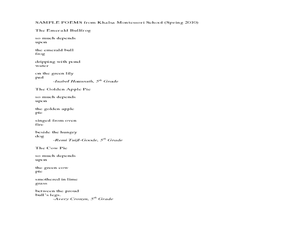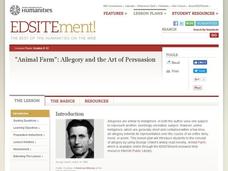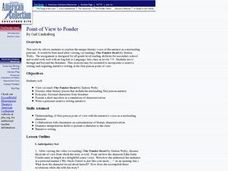Curated OER
Macbeth
High schoolers examine patterns of imagery in Macbeth by using online resources. Students compare the patterns they see to those they've found in other Shakespeare plays. Then high schoolers draw conclusions about why Shakespeare might...
Curated OER
Othello
Learners examine patterns of imagery in Othello by using online resources. Students compare the patterns they see to those they've found in other Shakespeare plays. Then learners draw conclusions about why Shakespeare might have used the...
Curated OER
Merchant of Venice
High schoolers examine patterns of imagery in Merchant of Venice by using online resources. Students compare the patterns they see to those they've found in other Shakespeare plays. Then high schoolers draw conclusions about why...
Curated OER
Figurative Language Alive: Balcony Scene Charades
Students act out lines from Romeo and Juliet in a charade-like game.
Curated OER
Figurative Language
Students create a PowerPoint show illustrating two types of figurative language. They demonstrate understanding of personification by creating and interpreting simple examples. They also demonstrate understanding of alliteration.
Curated OER
Lesson Plan with Technology - Introduction to Elements and Symbols
Learners use a computer program to study elements and the periodic table. They follow the directions on the computer program, and answer the questions presented. The program is self scoring, and students may print a certificate that...
Curated OER
BE MY VALENTINE!
In this Valentine's worksheet, students read and analyze a short article about Valentine's Day and then answer five questions over the content of what they've read.
Curated OER
We the Past
Learners study philanthropy related terms and philanthropy in the United States and their local community. In this philanthropy lesson, students study pictures of present and past Americans and discuss their philanthropic acts. Learners...
Curated OER
Every Dog Has Its Day
Middle schoolers explore the use of imagery in writing. In this writing lesson, students create a writing piece that features sensory images without resorting to the use of clichés.
Curated OER
Fairness Metaphor
Middle schoolers write a metaphor. In this descriptive writing lesson, students define metaphor. Middle schoolers come up with a creative metaphor to describe their feelings about fair practices related to music downloads.
Curated OER
The Red Wheelbarrow
Students explore an imagist poem. For this poetry lesson students write a poem in the imagist's style using "The Red Wheelbarrow" by William Carlos Williams as an example. The poems are read aloud and discussed.
Curated OER
Onomatopoeia
Fifth graders investigate onomatopoeia. In this reading lesson, 5th graders create a list of onomatopoeic words from books read and brainstorm words of their own in small groups.
Curated OER
Similes and Metaphors Information
In this similes and metaphors worksheet, students write a descriptive practice paragraph in which they describe a place, idea, person, event, or concept without telling what the subject of the paragraph is. Students then pair up to...
Curated OER
Alliteration
In this alliteration worksheet, 4th graders write alliterations with their first names, find rhyming patterns in poems, and more. Students complete 4 activities.
National Endowment for the Humanities
Animal Farm: Allegory and the Art of Persuasion
Introduce your class members to allegory and propaganda with a series of activities designed to accompany a study of George Orwell's Animal Farm. Readers examine the text as an allegory, consider the parallels to collective farms...
Maryland Department of Education
A Raisin in the Sun and Dreams Deferred
To conclude a study of A Raisin in the Sun and to prepare for a visit to the Lewis Museum, class members analyze Langston Hughes' poem "Harlem." Learners then draw connections to characters in the play and to their own experiences...
Curated OER
Our Town
With the songs "My Hometown" by Bruce Springsteen and "Allentown" by Billy Joel, learners examine external versus internal conflict. When they have finished the first part of the activity, they create their own poem (or song) about the...
Fluence Learning
Writing an Argument: Persuasive Speeches to Students
Powerful orators make their messages compelling with a combination of factors. Learn how to be an inspirational speaker with a reading assessment activity that presents a list of persuasive speaking techniques, as well as two...
New Jersey Historical Commission and New Jersey Council for the Humanities
Thomas Edison: The Wizard of Menlo Park
What would change in your daily life due to a power outage? Here, learners explore the inventions brought to us by the one and only, Thomas Edison, and imagine a day without them. Scholars take part in a grand conversation and write a...
Curated OER
Browning's "My Last Duchess" and Dramatic Monologue
Learners read and analyze the poem, "My Last Duchess," by Robert Browning. They examine the use of dramatic monologue as a poetic device, and write a character profile of the Duke.
T. Smith Publishing
Finding Percentages 6A
A list of 20 two to three-digit numbers asks math whizzes to determine specified percentages for each. The publisher has linked the assignment to CCSS.Math.Content.6RP.3, and it is targeted at the discreet skill of finding a percent of a...
Curated OER
Point of View to Ponder
Students view (or read) The Ponder Heart by Eudora Welty. They
discuss other literary pieces that include the misleading first person narrator. They
role play fictional characters from literature and present a short anecdote in a...
Curated OER
Where the Red Fern Grows Chapter 19-20
Take a look at the final chapters of Wilson Rawls' much-loved novel. Class members respond to several plot-based questions and then consider the red fern as a symbol. The worksheet is part of a series that includes every chapter except...
Curated OER
Where the Red Fern Grows Chapter 16-17
Find out how much your class understood of the listed chapters of Wilson Rawls' novel. Class members respond to eight plot and character questions before looking closely at an instance of personification from the text. The resource is...

























